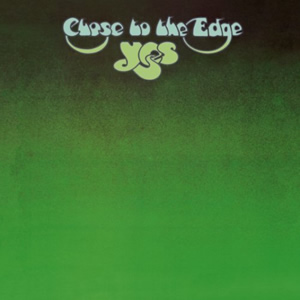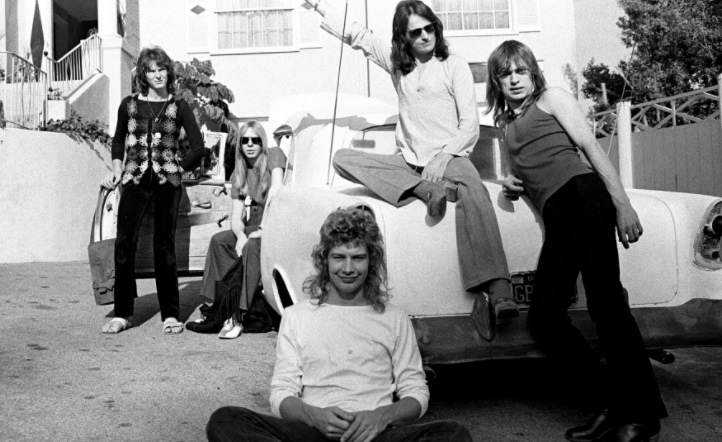Close to the Edge by Yes
 The group Yes reached their progressive pinnacle with the 1972 album Close to the Edge. Containing just three extended tracks, the album became Yes’s greatest commercial success to date, reaching the Top 5 on both the US and UK album charts. However, this success did not come without cost as the complex arrangements and stressful studio situation ultimately led to the departure of drummer Bill Bruford.
The group Yes reached their progressive pinnacle with the 1972 album Close to the Edge. Containing just three extended tracks, the album became Yes’s greatest commercial success to date, reaching the Top 5 on both the US and UK album charts. However, this success did not come without cost as the complex arrangements and stressful studio situation ultimately led to the departure of drummer Bill Bruford.
Following the success of the group’s fourth LP, Fragile, Yes went on an extensive tour. In early 1972, they recorded a cover of Paul Simon’s “America” for an Atlantic Records compilation album and by the Spring of that year, they were back at Advision Studios in London with audio engineer and co-producer Eddy Offord.
None of the tracks on this album were fully written prior to entering the studio and there were several instances where the arrangements had gotten so complex that the band members forgot where they left off the previous day. Offord had worked with Yes on tour and tried to replicate their live energy by building a large stage in the studio. However the arduous process took its toll, especially on Bruford and keyboardist Rick Wakeman, who felt like “innocent bystanders” to the thematic vision of the record.
 Close to the Edge by Yes |
|
|---|---|
| Released: September 13, 1972 (Atlantic) Produced by: Eddy Offord & Yes Recorded: Advision Studio, London, February–July 1972 |
|
| Side One | Side Two |
| Close to the Edge | And You and I Siberian Khatru |
| Group Musicians | |
| Jon Anderson – Lead Vocals Steve Howe – Guitars, Vocals Rick Wakeman – Keyboardss Chris Squire – Bass, Vocals Bill Bruford – Drums, Percussion |
|
Close to the Edge opens with the ambient noise of nature and a world at ease before this vibe is quickly demolished by a piercing, psychedelic guitar lead by Steve Howe, which is impressive technically and interesting in its style. In contrast are Bruford’s rhythms and a punchy baseline by Chris Squire, which make for a tension-filled listen at first, until the song breaks around the three minute mark with a more melodic and atmospheric guitar lead that shepherds the listener into the catchy heart of this 18-minute title track. Composed by Howe and lead vocalist Jon Anderson, the vastly differing textures and moods are taped together in an atmospheric dream-like presentation, with funk based guitar riffs giving way to a hymn-like section and church organ solo before the main theme is reprised (albeit with differing instrumental arrangement) to close out the track.
The album’s original second side, features extended tracks clocking in at ten and nine minutes respectively. “And You and I” is a brilliant suite which offers listeners a completely different feel than that of the side-long title track. It opens with a beautiful, chime-filled acoustic guitar piece by Howe, somber in tone, but quickly picked up by a strong backing rhythm. Through its four distinct sections, the song transitions from folk to rock to a spacey, atmospheric piece with Wakeman’s synths, Squire’s pointed bass, and Howe’s guitars playing hand-in-hand. Eventually the song wraps brilliantly by returning to its folksy roots but with a differing rhythm to give the whole experience a forward motion.

The closing “Siberian Khatru” is the most straight-forward and, perhaps, the the easiest listen on the album. It features Yes’s unique combination of funk bass with more beautifully prominent guitar work, which really drives the song through from beginning to end. To achieve the unique sound of Howe’s guitar, Offord used two microphones, one stationary and a second swinging around to replicate a “Doppler effect”.
Bruford left to join King Crimson following the album’s completion and was replaced by Alan White, formerly of John Lennon’s Plastic Ono Band, for the the subsequent tour and albums in the immediate future. Impressed with the commercial and critical success of Close to the Edge, Atlantic Records owner Ahmet Ertegun signed the band to a new five-year contract, which carried Yes through the rest of the decade of the 1970s.
~
Part of Classic Rock Review’s celebration of 1972 albums.





December 22, 2019 @ 10:41 pm
To me this is Rock Music at its very best. The apex. Brilliance personified. So clean. The Symphonic Sound reaching its full potential. Their only weakness is a strong point by any other bands standard. Jon Anderzon who is a oytstanding vocalist but I aways thought Peter Gabriel was slightly better with Genesis IMO.
January 30, 2020 @ 10:28 pm
Great article. I’ve recently rediscovered this album and you’ve nicely captured the musical flourishes and wanderings. Interesting comment above. I’ve often felt that both singers seem to be directly addressing the listener.